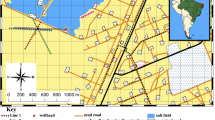Abstract
Emission tomography used in passive seismic monitoring of hydrocarbon deposits enables regular inspection of development of hydraulic fracturing and relaxation processes in volumes of fracturing, tracing of fluid migration paths, redistribution of stresses due to field development accompanied by seismic emission from volumes of structural defects and stress concentration, and localization of fractured and faulted structures from emission and scattering data. Intensive man-made seismic noise in the areas of oil field development produces a strong screening effect in identification of weak deep seismic sources. On the basis of experiments with simulated and real data of surface seismic arrays in regions of oil deposits in Western Siberia (carried out in the framework of the passive monitoring program of the SYNAPSE Science Center), it is shown that the use of algorithms of adaptive optimal and rejection spatial filtering with the estimation of the spectral density matrix of multichannel observations in the framework of multivariate autoregressive-moving average modeling is effective for eliminating the influence of anthropogenic noise and revealing (in oil production areas) both deep seismic sources supposedly active in scattering regions of the lower part of the sedimentary cover and the crystalline basement. The projection of the scattering regions onto the horizontal plane correlates well with the position of faults in the area of in situ observations.
Similar content being viewed by others
References
S. I. Aleksandrov and L. N. Rykunov, “Noise Monitoring in Southern Iceland,” Dokl. Akad. Nauk 326(5), 808–810 (1992).
S. I. Aleksandrov and K. M. Mirzoev, “Monitoring of Endogenous Microseismic Radiation in the Romashkino Oil Deposit Are,” in Problems of Geomorphology, Ed. by A. V. Nikolaev (Nauka, Moscow, 1997), pp. 176–188 [in Russian].
S. I. Aleksandrov, G. N. Gogonenkov, and V. A. Mishin, “Application of Passive Seismic Observations to Monitoring of Formation Hydrofracture Parameters,” Neft. Khoz., No. 5 (2005).
K. Arnason and O. G. Flovenz, “Evaluation of Physical Methods in Geothermal Exploration of Rifted Volcanic Crust,” Geotherm. Res. Counc. 16, 207–214 (1992).
J. Capon, “High-Resolution Spatiotemporal Spectral Analysis,” Proc. IEEE 57(8), 69–79 (1969).
B. Chouet, G. Saccorotti, P. Dawson, et al., “Broadband Measurements of the Sources of Explosions at Stromboli Volcano, Italy,” Geophys. Res. Lett. 26(13), 1937–1940 (1999).
M. Furumoto, T. Kunitomo, H. Inoue, and K. Yamaoka, “Seismic Image of the Volcanic Tremor Source at the Izu-Jshima Volcano, Japan,” in The Volcanic Seismology, Ed. by P. Gasparini, R. Scarpa, and K. Aki. (Springer, New York, 1992), pp. 201–211.
E. D. Glukhmanchuk, “Detection, Mapping, and Classi-fication of Fractured Reservoirs and Active Faults in a Sedimentary Sequence from Seismic and Other Geophysical Data” (2004), pp. 1–4 (http://www.uriit.ru/version/ ru/content/page_571_0_353.html).
Yu. A. Kugaenko, V. A. Saltykov, V. I. Sinitsyn, and V. N. Chebrov, “Emission Tomography Application to the Localization of Seismic Noise Sources Associated with Hydrothermal Activity,” Fiz. Zemli, No. 2, 66–81 (2004) [Izvestiya, Phys. Solid Earth 40, 149–162 (2004)].
A. F. Kushnir, “Estimation of the Plane Wave Apparent Slowness Vector from Three-Component Seismic Array Data: A Statistical Problem with Noisy Parameters,” in Computational Seismology (1997) Vol. 29, 215–233 [in Russian].
A. F. Kushnir and S. V. Mostovoi, Statistical Analysis of Geophysical Fields (Naukova Dumka, Kiev, 1990) [in Russian].
A. F. Kushnir and V. M. Lapshin, “Recognition and Identification of a Signal Waveform in Coda profile a Strong Interfering Event,” Computational Seismology (1997) Vol. 29, 197–214 (1997).
A. V. Nikolaev, P. A. Troitskii, and I. Ya. Tchebotareva, “Seismic Noise Application to the Study of the Lithosphere,” Dokl. Akad. Nauk SSSR 282(9), 586–591 (1986).
H. Sato and M. C. Fehler, Seismic Wave Propagation and Scattering in the Heterogeneous Earth (Springer, New York, 1998).
E. A. Sharifullina, Analysis of Development of Licensed Areas in the Middle Ob Oil-and-Gas Province under Conditions of the Contemporary Use of Mineral Resources, Extended Abstract of Cand. Sci. (Geol.-Miner.) Dissertation, TyumGNGU, Tyumen, 2004, p. 20.
B. M. Shubik and A. B. Ermakov, “Automatic Determination of Coordinates and Occurrence Times of Seismic Events Based on the Principles of Emission Tomography,” in Problems of Geothomography, Ed. by A. V. Nikolaev (Nauka, Moscow, 1997) [in Russian].
I. I. Tchebotareva and A. V. Nikolaev, “Exploration of Crustal Heterogeneities Using Earthquake Codas,” Dokl. Akad. Nauk 364(6), 816–820 (1998).
I. I. Tchebotareva, A. V. Nikolaev, and H. Sato, “Seismic Emission Activity of Earth’s Crust in Northern Kanto, Japan,” Phys Earth Planet. Inter. 120(3), 167–182 (2000).
J. Um and C. Thurber, “A Fast Algorithm for Two-Point Seismic Ray Tracing,” Bull. Seismol. Soc. Am. 77(3), 972–986 (1987).
Author information
Authors and Affiliations
Additional information
Original Russian Text © I.Ya. Chebotareva, A.F. Kushnir, M.V. Rozhkov, 2008, published in Fizika Zemli, 2008, No. 12, pp. 65–82.
Rights and permissions
About this article
Cite this article
Chebotareva, I.Y., Kushnir, A.F. & Rozhkov, M.V. Elimination of high-amplitude noise during passive monitoring of hydrocarbon deposits by the emission tomography method. Izv., Phys. Solid Earth 44, 1002–1017 (2008). https://doi.org/10.1134/S1069351308120033
Received:
Published:
Issue Date:
DOI: https://doi.org/10.1134/S1069351308120033




